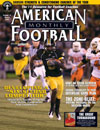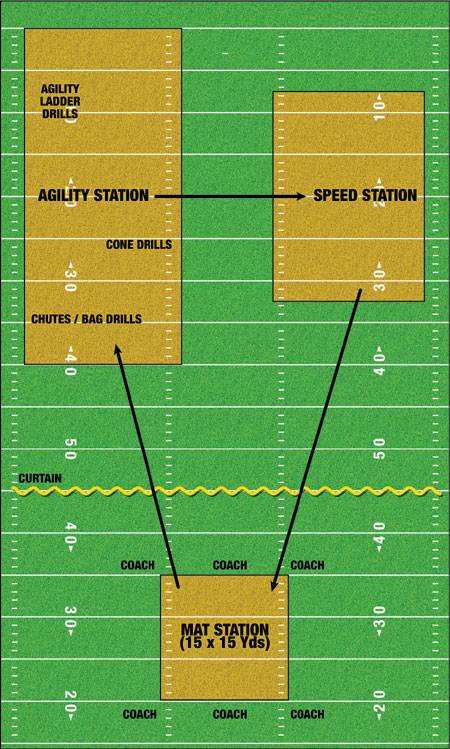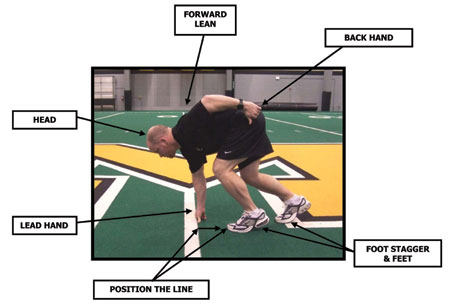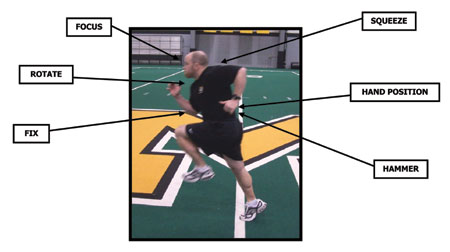AMERICAN FOOTBALL MONTHLY THE #1 RESOURCE FOR FOOTBALL COACHES
Article CategoriesAFM Magazine
|
Developing a “Six-second competitor”by: Mike KucharSenior Writer, American Football Monthly © More from this issue Missouri’s secret program that builds toughness and confidence It’s no secret that Missouri has been one of the most improved college football teams in the country over the last five years. Under Head Coach Gary Pinkel, the Tigers have won back-to-back Big 12 North Championships and had four bowl appearances in the last four seasons. Pinkel has won 31 out of his last 42 games as a head coach. The numbers speak for themselves. Those numbers, some would say, have a lot to do with having the 2007 All-Big 12 QB and a 2008 All-American receiver. But to those inside the program, the real secret to Pinkel’s and the Tigers’ success is what happens on the Columbia campus during the winter months, specifically at 6:00 a.m. every Tuesday and Thursday. That’s when players participate in the grueling workout known as “The Winning Edge”. Developing the Six-second Competitor When Pinkel first got the job at Missouri, one of his immediate objectives was to develop mental toughness. It didn’t take him long to do it. An apprentice of legendary coach Don James and a teammate of QB-killer and former NFL Pro-Bowler Jack Lambert at Kent State, Pinkel wanted to bring that kind of intensity to his players. So he developed The Winning Edge – a gut-wrenching morning workout program that focused on sharpening the mind and toughening the body. “Our winter program is probably the best thing we do at Missouri,” said Pinkel. “When we first got here in 2001, we were looking for a change in attitude. We wanted to change the confidence level of the players. We wanted the players to feel good about what they are doing. If they feel good about themselves, they will play better.” The Winning Edge is centered on a “six-second competitor” philosophy. Since most football plays average four to six seconds in length, Pinkel and Mizzou strength and conditioning coach Josh Stoner felt that it was necessary to over-train their athletes by giving them short bursts of intensity at a time. “Since you can’t conduct official practices during January when we start this program, it is critical that you design an off-season program that emphasizes attention to detail, creates a six-second competitor and demands a high level of focus to create mentally tough athletes,” said Stoner. Starting after the holiday break and lasting five weeks, the Winning Edge program combines speed, agility and discipline. It is only 75 minutes long, but it may seem like an eternity for those who are participating. According to Pinkel, what the athletes do is not as important as how they do it. “We insist that the players do the drills the right way or they do them over,” said Pinkel. “Then we carry that over to the football field. We are very much disciplined and we want things done right. It is done right at full speed or we have them do it over.” The Program At 6:00 a.m., the doors lock to the Dan Devine Indoor Pavilion. Players, still groggy from crawling out of bed, start by taking a two-lap warm-up around the football field. At this time, Stoner will bark out the station assignments for the day. Players are asked to focus by listening to his commands as they are running in order to ensure for a clean, disciplined start to the morning. After taking the two initial laps, players jog to a designated stretch line which takes another eight minutes. At 6:13, the team is divided into three equal groups that will remain together throughout the duration of the workout. “Organization is paramount,” said Stoner. “The organization and the attention to detail and high demand for enthusiasm from the coaches are the keys.” For the most part, Stoner likes to divide the team into three groups of around 30 players each: Group 1: Offensive and defensive linemen Group 2: Tight ends, linebackers, running backs, QB’s and specialists Group 3: Wide receivers and defensive backs The Pavilion is divided into three stations: agility, speed and the mats with coaches waiting for their respective groups (See Diagram 1). 
According to Stoner, each station has a different objective. The players are asked – make that demanded – to get through each station in 17 minutes. It must be crisp, and it must be efficient with little time to waste. If players don’t get it right on a particular drill, the clock will continue. “The players are never allowed to put their hands on their knees,” said Pinkel. “It doesn’t matter how tired they get, they do not put their hands on their knees. It shows the opponents you are weak.” Station 1: Speed Improvement According to Stoner, this is more of a technique-oriented drill. Top speed is rarely emphasized. Rather, it is the mechanics of the proper form that each coach stresses. “The speed improvement techniques will be done at three-quarter speed based on the level of mastery among the athletes,” said Stoner. “The 40 stance (See Diagram 2) 
is coached on every rep. The coach will give the athletes enough time to get into their stances before giving them the “go” command. Upon the “go” command, the athlete will explode for two steps and then begin the drill at five yards.” The speed development drills include marches, skips, high knees, butt kicks, backwards run, bounding and single-leg hops. Again, the activity or speed is never as important as the form, according to Stoner. Players are taught ten terms that define how their upper body and lower body should be positioned (See Diagrams 3 and 4). 
Upper Body Diagram 3. Focus – eyes straight ahead, as if you were talking to someone your own height. Pick a point off into the distance at the same height as your eyes and stare at it. Hand Position – palms are toward the midline of the body, fingers are curled in with the thumb on the forefinger. Hands facing torso. Hands relaxed, not clenched. Fix – fix a 90-degree angle in the elbow joint and do not let it change during the arm action. Rotate – move the arms through a full range of motion, emphasizing the back portion of the movement. Squeeze – anytime the elbows move away from the midline you get a rotational force, so you must concentrate on getting your elbows tight against your body. Hammer – the arm movement downward should be a violent motion. The knuckles must be in a down and back position (with palms toward the midline of the body) as though standing with your back to a wall hammering a nail into the wall. 
Lower Body Diagram 4. Arch – there should be a slight arch in both upper and lower back. a. Upper back – shoulder blades should be slightly toward the midline of the body, squeeze them together. b. Lower back – arched so that the hips are underneath the athlete. c. Slight angular body lean – do not bend at the waist. Keep the body as rigid as possible. Punch – the knee is driven forward with the toe up. The chest should remain tall and not dip toward the knee. Punch the knee through the wall in front of you. Foot Plant – the fore leg snaps down and back underneath the hips, not directly underneath you, but slightly behind. The player should be striking with the ball of the foot. Extension – locking out the plant leg to full extension. In order to ensure clarity and eliminate confusion, it is each coach’s job to use the same terminology to describe the movement. “It’s important that they use the same vocabulary in order for all athletes to understand each coach that will interact with them to correct any flaws,” said Stoner. “It cuts down the learning curve.” Station 2: The Mats According to Pinkel, the mats are the most intense segment of the Winning Edge. Thirty players group up into three lines on a 15-by-15-foot wrestling mat. There are ten players in a line waiting for a command from the coach. According to Stoner, here is where you put your most intense coaches, so it is not surprising to see the offensive and defensive line coaches manning this station. Like the speed station, there are certain commands used here that players must adhere to. They include the following: “Breakdown” - first two lines assume an athletic stance - head up, feet wide, hands off thighs. “Set” - first line starts chopping their feet. “Go” - line executes the drill. “Ready-Ready” - return to the athletic position chopping the feet and evening out the line while waiting for the next command. “Fire Out” - line sprints across the mat, does a forward seat roll at the end of the mat and comes up chopping their feet. The coach will point to a direction at times and have players exit a certain way. This is where the “six-second competitor” philosophy is honed. Each drill is six seconds in duration and must be done with great speed and quickness. Some of the drills on the mat include a shuffle wave drill, a two-point seat roll, a four-point seat roll, a mirror drill where players have to mimic a “rabbit” movement, and quarter-eagle turns. Again, the emphasis here is on intensity and quickness. “It’s organized chaos, really,” says Stoner. “Drills will be done fast with high attention to detail. Everything is done at full speed. Mistakes and loafing will result in that line repeating the drill until it is done right. Coaches are barking out commands and demanding high energy at all times. The money is made, so to speak, during the mat station.” Station 3: Agility Finally, the agility station is split up into two sections with both sections at eight minutes in duration. The instructors’ commands are the same as speed development: breakdown, set, and go. The first section will be working on the following: 1. Bag Agilities- Usually done under a blocking chute to ensure leverage. 2. Cone Drills- These can be a pro agility, four-cone agility or some type of movement drill. 3. Ladder Drills- Two speed ladders are set up 10 yards apart in which players will work high knees, shuffles, skips, hops, etc. While the first section is working on that, the latter section will be working on team agilities or what Stoner calls reactive drills. The drills and their coaching points are as follows: 1. Back Pedal - Staying low, keep center of gravity over the toes 2. Back Pedal, Turn and Run - Back pedal as fast as possible, on the coach’s signal turn and run through the line. 3. Back Pedal, Weave - Back pedal as fast as possible and turn in the direction given by the coach. 4. Back Pedal, Shuffle - Back pedal as fast as possible, turn in the direction given by the coach and shuffle. 5. Back Pedal, Double Turn - Back pedal as fast as possible, on the coach’s signal turn each time and run through the line. With the conclusion of each 17-minute station, athletes are expected to run to the next station at the sound of the horn. Although many teams have incorporated some form of early-morning workouts, Stoner suggests that a structure similar to “The Winning Edge” can be applied to any level of football as long as there are coaches willing to spend the time. It’s worked for Missouri, and it can work for you. |
|
| HOME |
MAGAZINE |
SUBSCRIBE | ONLINE COLUMNISTS | COACHING VIDEOS |
Copyright 2024, AmericanFootballMonthly.com
All Rights Reserved




